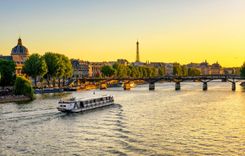19. Le Stes-Maries-de-la-Mer, Provence
Set deep in the Camargue, where the Rhône meets the Mediterranean, Les Saintes-Maries-de-la-Mer is all white-washed buildings, terracotta rooftops and searing sunlight. From the town’s compact center, a ribbon of beaches curves westward – a series of small crescents carved out by stone breakwaters. In summer, they’re packed with swimmers, families and windsurfers making the most of the warm, shallow waters and consistent breezes.
The sand here is coarse and pale, the vibe relaxed, and the town still retains hints of its fishing–village roots. It’s also a major pilgrimage site for the Roma community, adding a layer of cultural significance to what at first glance looks like a typical seaside town. To the east, the pleasure port offers boat trips into the surrounding lagoons – great for spotting flamingos and wild horses – or fishing outings for those wanting to get out on the water.
How to get to Le Stes-Maries-de-la-Mer
The town is about 45 minutes by car from Arles – the nearest major transport hub. There’s limited public transport, so driving is by far the easiest option. Once there, everything is within walking distance, including the beaches, harbor and church at the town’s heart.
20. Paloma Beach, Saint-Jean-Cap-Ferrat
Paloma Beach is where Riviera daydreams get real – a small, polished cove on the north side of Pointe de Saint-Hospice, tucked away on Cap Ferrat’s exclusive coastline. With its pale pebbles, crystal-clear waters and forested backdrop, it’s easy to see why this beach has long been a favorite of the well–heeled. From the water, modern yachts drift silently just offshore, while from land, you reach the beach via shady footpaths that crisscross the peninsula.
Cap Ferrat itself is quiet – there’s no through traffic, and the one town, Saint-Jean-Cap-Ferrat, feels like a postcard version of Riviera luxury. The coastal trail around the cape is open to all and offers stunning views across Villefranche-sur-Mer and beyond. Paloma Beach has a private section with loungers and a restaurant, but there's also public access if you don’t mind skipping the table service.
How to get to Paloma Beach
Saint-Jean-Cap-Ferrat is around 30 minutes by bus or car from Nice. You can also reach it by train to Beaulieu-sur-Mer, then walk or take a taxi the rest of the way. From the town center, the beach is a 10–minute walk along marked coastal paths. Parking is limited – come early or avoid bringing a car altogether.

























